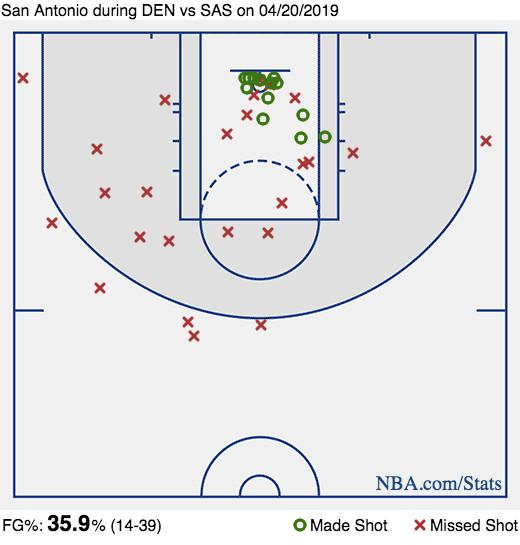Rooting for the Spurs has spoiled me. Gregg Popovich boldly installed himself as head coach in 1996, drafted Tim Duncan in 1997, and the rest, as they say, is history. In this case, history includes five NBA titles, 22 straight playoff appearances, and the well-earned reputation as the NBA’s model franchise.
In a copycat league, the Spurs stand out as pioneers. Their success at the back end of the draft, and especially with international players, is unmatched; they were one of the first teams to embrace the corner 3; they designed a defense that could once slow down James Harden. San Antonio has powered its extended run of success with ingenuity, adaptability, and creativity—which is why it has been so perplexing to see the team launch midrange jumpers with the same fervor that the rest of the league has embraced the 3. The NBA’s model franchise is butting heads with the model.
Some stats: Per Cleaning the Glass, 46.9 percent of the Spurs’ total shots this regular season came from the midrange. That is the highest share in the league, a full 11 percentage points higher than Minnesota, the next-most midrange-happy team. (For reference, Minnesota is 11.2 percentage points ahead of Utah, which shoots the fourth fewest in the NBA.) The Spurs’ two highest-usage players, DeMar DeRozan and LaMarcus Aldridge, finished nos. 1 and 2 in midrange shots taken per game and total for the season, per NBA.com/Stats. By definition, these shots must come at the expense of more valuable ones; and sure enough, San Antonio ranked 30th in both percentage of shots at the rim and from 3. Taken together, these stats paint the picture of a team that has doubled down on the least efficient shot on the court.
How can such a demonstrably smart and forward-thinking team embrace, or at least tolerate, such a high volume of midrange jumpers? As a Spurs fan and Popophile, I have spent much of this season trying to understand and come to grips with this. Is this another of Pop’s master strokes, or [whispers] just the end of an empire? During each game of the Spurs’ first-round series against the Denver Nuggets before Thursday’s Game 6, and really throughout this season, I have gone through a constant push and pull that resembles the Alonzo Mourning GIF.
On the one hand: Aldridge and DeRozan are special basketball players. An LMA pick-and-pop is as good a release valve as any, and DeRozan is an expert at snaking through the lane and pulling up or pivoting into fading jumpers. The shots may be suboptimal, but someone has to shoot, and the Spurs have designed an offense around the most dangerous weapons of their two best offensive players. They’ve even surrounded those two with above-average shooters from beyond the arc, and crafted a deliberate offensive system that works to get those shots in rhythm. It may not be the Rockets (thank God), but it’s hard to argue with that reasoning. And it’s worked! The Spurs finished the season with the sixth-highest offensive rating.
On the other hand:
Shots like this are extremely damaging to my intellectual gymnastics routine, and they happen too often to overlook completely (DeRozan is not the only offender). I do think there is a point to be made about how open and in-rhythm midrange jumpers have become undervalued as teams adjust their defensive schemes to defend the higher-value 3-pointers. But the Spurs take so many tough ones from the wrong areas of the floor that their games often seem like uphill battles. That has been especially evident so far in the playoffs. San Antonio has played inspired basketball and challenged the 2-seed Nuggets, but it’s hard to overcome the 3-point discrepancy: Denver shot 15-for-31 from downtown compared to the Spurs’ 5-for-17 in Game 4, and then doubled them up in Game 5; San Antonio lost both games, and is now down 3-2 in the series. Over the second and third quarters of Game 4, the Nuggets outscored the Spurs by 24, and the Spurs’ shot chart looked like this:

Sustaining an offensive run or breaking out of an offensive rut against dialed-in defenses with that kind of shot selection is a daunting task. It’s frustrating, but it’s the path they chose—and that many expected—when they paired DeRozan and Aldridge. Ironically, the playoffs have revealed we were right about the Spurs all along: On the brink of elimination, it looks like Pop didn’t outsmart us this time. But with the emergence of Derrick White, Bryn Forbes, Jakob Poeltl, and Davis Bertans, the Spurs have positioned themselves well for the future and reminded us why we trusted them in the first place.
If the Spurs lose to the Nuggets, don’t dismiss them as a failed experiment. Despite their flaws, they won 48 games, proved to be a handful in the playoffs, and challenged us to at least reconsider what we know about NBA offense. It’s heartening to watch a team that knows exactly who it is. Their effort and execution on both ends of the floor is admirable. Despite my frustration, their nightly battle against the true-shooting-percentage odds has been surprisingly galvanizing. They play their way, and with conviction, just like they always have. That’s why this series feels imbued with meaning. Though I would beg Pop for fewer midrange jumpers in Game 6 if I could, I also want San Antonio to prove that you don’t have to capitulate to widely accepted principles if you can overcome them. It’s been a weird year for me as a Spurs fan: reconciling my unshakeable trust in Pop against my faith in analytical principles. Math will come out on top eventually, but that doesn’t mean I haven’t enjoyed the ride.
